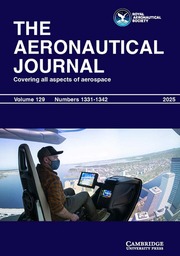No CrossRef data available.
Article contents
Effects of a central straight on anS-shaped diffusing duct
Published online by Cambridge University Press: 04 July 2016
Extract
Some earlier investigations on the flows in S-shapeddiffusing ducts suggested that the first bend wasthe primary source of pressure loss and engine-faceflow distortion, e.g., Goldsmith. By increasing thecurvature ratio (ratio of the duct curvature to theduct inlet cross-sectional diameter) of the firstbend and by incorporation of a straight diffuserjoining the end of the first bend and the inlet ofthe second bend, a significant improvement in thetotal pressure recovery at the engine face could beachieved (Fig. 1). A large proportion of the gain inthe total pressure was attributed to the centralstraight diffuser. Results at a lower inlet speed(incompressible; inlet Reynolds number about 60 000)in the same ducts by Ho, Myring andLivesey(2) revealed the same trend asin the original high inlet speed reported byGoldsmith(1) (compressible; inlet Machnumber from 0·4 to 0·8; inlet Reynolds number overone million). However, changing the curvature ratioin the first bend also changes the direction of theaxis of the inlet plane, which should be aligned inthe same direction as the axis of the exit plane(cf Fig. 1). Thus, the previousexperiments were actually comparing ducts atdifferent angles of attack relative to the axis ofthe exit plane; in relation to a typical jetaircraft intake installation. Hence, theeffectiveness of the straight diffuser at zero angleof attack (relative to the axes of the inlet andexit planes) on the overall total pressure recoveryin an S-shaped duct had not been assessed.
Information
- Type
- Technical Note
- Information
- Copyright
- Copyright © Royal Aeronautical Society 1996

